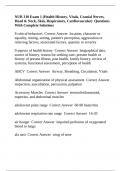NUR 310 Exam 1 (Health History, Vitals, Cranial Nerves,
Head & Neck, Skin, Respiratory, Cardiovascular) Questions
With Complete Solutions
8 critical behaviors Correct Answer location, character or
equality, timing, setting, patient's perception, aggravation or
relieving factors, associated factors, quantity or severity
9 aspects of health history Correct Answer biographical data,
source of history, reason for seeking care, present health or
history of present illness, past health, family history, review of
systems, functional assessment, perception of health
ABCV Correct Answer Airway, Breathing, Circulation, Vitals
Abdominal organization of physical assessment Correct Answer
inspection, auscultation, percussion, palpation
Accessory Muscles Correct Answer sternocleidomastoid,
trapezius, and abdominal muscles
adolescent pulse range Correct Answer 60-90 beats/min
adolescent respiration rate range Correct Answer 16-20
air hunger Correct Answer impaired perfusion of oxygenated
blood to lungs
ala nasi Correct Answer wing of nose
,Alcohol CAGE Correct Answer Cut down, annoyed, guilty,
eye opener
alopecia Correct Answer partial or complete loss of hair
anasarca Correct Answer generalize edema
Angle of Louis Correct Answer sternal angle, palpate as
prominence on upper third of sternum
anorexia/ constipation Correct Answer marginal perfusion of
GI tract
Aortic area Correct Answer 2nd ICS, right sternal boarder (SB)
AP diameter: Lateral diameter Correct Answer 1:2
Apicul pulse Correct Answer normal pulsation located over
apex of the heart
apnea Correct Answer respiration ceased for at least several
seconds
Arrhythmia Correct Answer pulse lacks normal, regular rhythm
Auscultatory gap Correct Answer associated with an increase
in BP, sound disappears then returns
Barrel Chest Correct Answer rounded appearance of horizontal
ribs
, Bell of stethoscope Correct Answer low-pitched sounds (extra
heart sounds)
Biots Correct Answer irregular patterns of breathing, series of
normal breathing followed by apnea, length of cycle varies,
associated with brain abnormalities
Blood Pressure (BP) Formula Correct Answer Cardiac Output
(CO) x Peripheral Vascular Resistance (PVR)
Bradycardia Correct Answer < 60 beats/min
Bradypnea Correct Answer < 10 breaths/min
Bronchial/ Tracheal breath sounds Correct Answer loud, high-
pitched tubular sounds over trachea and major bronchi, loudest
during expiration
Broncho vesicular breath sounds Correct Answer moderately
pitched b/w scapulae and either side of sternum
Bruits Correct Answer blowing, purring sound that indicates
distortion of blood vessel, heard in carotid, brachial, radial,
aortic, renal, iliac and femoral arteries
bulbar conjuntiva Correct Answer transparent membrane over
the sclera
Bulla Correct Answer vesicle larger than 1 cm, unilocular,
superficial in epidermis, thin walled (friction blister, burns)




